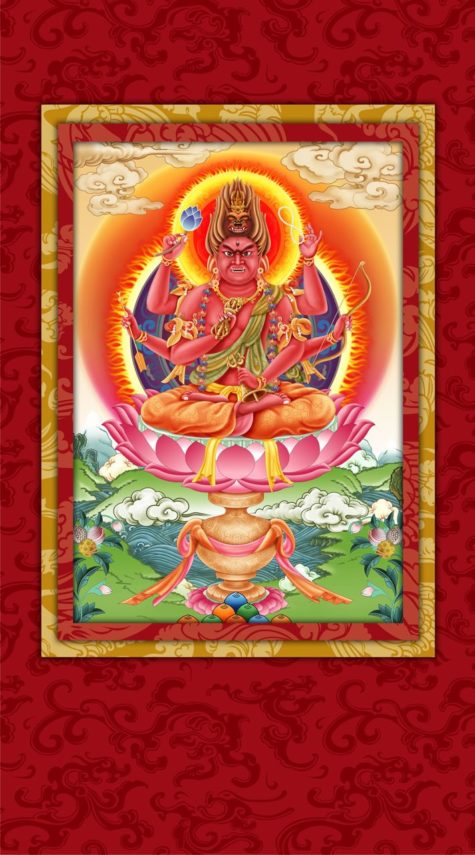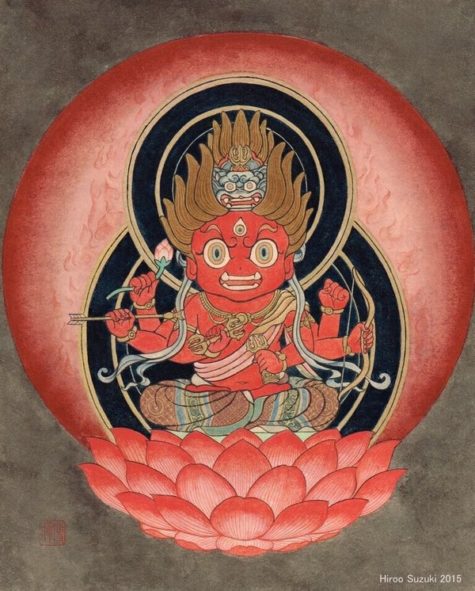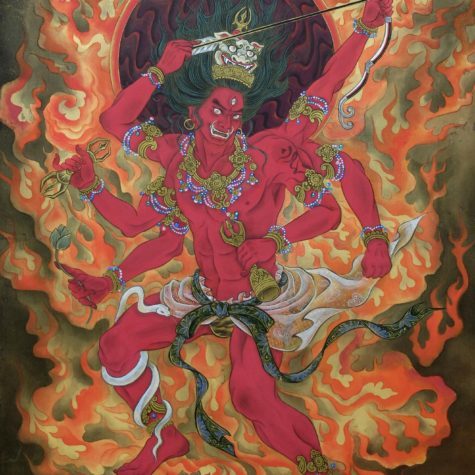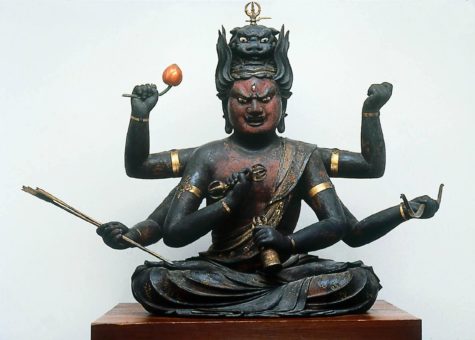Aizen-Myōō, also known as Rāgarāja, is one of the five Wisdom Kings. Other titles and names include the following:
- Lord of Passion
- King of Lust
- Lust-Drenched One
- Impassioned One
- King of Sexual Passion
Ragaraja, Buddhist Lord of Passion, traveled from India to Japan, where he transformed into Aizen Myo’o, venerated by Japan’s esoteric Buddhist sects as King of Love, Lust, and Desire, patron of erotic love and sacred sexuality. He helps convert earthly, physical desires into transcendent love and spiritual awakening.
He is portrayed as a red-skinned man with a fearsome appearance, a vertical third eye and flaming wild hair that represents rage, lust and passion. Also the Lustful-Tinted Wisdom King was popular among Chinese tradesmen who worked in the fabric-dying craft, typically accomplished with sorghum.
He is still venerated as a patron of landlords, prostitutes, homosexuals and petitioned by devotees for a peaceful home and abundant fortune in business. There is usually a lion’s head on top of his head in his hair, representing the mouth into which thoughts and wishes may be fed. Some of these are the wishes of local devotees who make formal requests for success in marriage and sexual relations.
Aizen Myo’o is King of Lust because he helps control it, explore it, or transform it into enlightenment. He is petitioned for assistance with the physical and emotional frustrations of suppressed sexuality. Aizen Myo’o is revered as patron of gay love, but he may be invoked for assistance with any kind of love or romance, including self love.
Aizen converts earthly desires (love/lust) into spiritual awakening, and saves people from the pain that comes with love. Aizen is celebrated in Japanese rites to achieve harmony and friendship, to succeed in one’s romantic endeavors, to gain the love and respect of others, and to reach a clear understanding of the Dharma (Buddhist law).
- Favored People:
Aizen Myo’o guards prostitutes and sex workers. He is venerated by those for whom sex is a business, including sex shop owners and those working with any form of pornography or erotica. He is also venerated by singers, musicians and landlords.
He is the patron deity of dyers, possibly because the second part of his name means “dye” or “to dye” (hence “soaked”).
Today, Aizen is revered in Japan’s gay quarters as the patron of love. Aizen does not appear in Indian texts, and is unknown among India’s deities.
- Iconography
Aizen is usually depicted with a red body possessing eight arms and three eyes on an angry face. A lion’s head rests in his hair, symbolizing passion. He carries bows and arrows, which symbolize love as well as his role as a destroyer of evil. Aizen’s red body symbolizes the power to purify sexual desire. He is typically bright red, suggesting the force of the passions, yet, at the same time, the vigor of his compassion.
He is portrayed as a red-skinned, frowning man, his appearance representing suppressed lust and passion. He variously has two, four or six arms; in the latter form, his hands bear a bell, a stick, a thunderbolt, a lotus, a bow and an arrow. Similarly, he sometimes has two heads, with a lion’s head in his wild hair.
His lion headdress indicates that Aizen possesses the strength of the five wisdom Buddhas. His three eyes are able to see the “three realms” of desire, form, and non-form.
His mouth is usually half-opened and reveals fangs. His hair is fiery and stands on end. Aizen is often surrounded by flames, which indicate the burning power of the passions. Aizen is usually seated on a lotus throne and carries a lotus flower in one of his four arms.
The most distinctive feature of Aizen is his bow and arrow, which is the best way to identify him (though it is sometimes missing). Interestingly, experts on Buddhist iconography are not agreed about the precise meaning of the bow and arrow.
All agree that it is a weapon against evil. Furthermore, according to some, it chases away carelessness and neglect (in observing Buddhist precepts).
For others, the arrow is Aizen’s love (somewhat like Cupid’s arrow), and, in another theory, it is the conquering strength of wisdom. Sometimes, Aizen holds a small mirror, a symbol of the void in Buddhism. He typically appears with six arms, but sometimes with only four.
The blood-red body and flaming halo of Aizen Myōō, the Wisdom King of Passion, represents the state at which sexual excitement or agitation becomes enlightenment and passionate love becomes compassion for all living things. In Buddhism, he manifests as a vajrasattva.
Aizen Myōō is the embodiment of rage: his hair stands on end, a snarling lion rises from his head, and his six arms brandish Esoteric Buddhist weapons and other emblems of power. The bow and arrow in his middle hands are attributes appropriated from Kama, the Hindu god of love.
Though fearsome in appearance, this wisdom king acts only out of love for others. In Japan, Aizen is thought to control the amorous passions, redirecting them to ward the struggle to overcome desires.
In contrast to this righteous anger, jewels of good fortune forming flaming clusters spill from a vase in front of the deity’s lotus throne. While Aizen Myōō’s appearance may instill fear, the faithful afflicted with problems of the heart address him as a popular intercessor.
The Rāgarāja Mantra
Appropriately, Rāgarāja’s mantras are pronounced in either Chinese or Japanese transliterations of Sanskrit; the cadences depending upon the respective region where his devotees reside and practice, and whether in the Shingon or Tendai schools. His seed vowel, as written in bonji, is pronounced “HUM,” usually with a forceful emphasis coming from the use of lower belly muscles.
To invoke Ragaraja, one needs to form his mudra and chant his mantra. While holding the mudra, rub the middle fingers against each other – this represents ”love to connect.” By invoking him in this way, Ragaraja will come quickly and descend into your body.
Here’s a video:
For the sake of the men and women in emotional distress, sentient beings engaged in love and passion, and couples who are separated and need to patch up their relationships, here is the Sadhana of the Ragaraja Affection Practice:
The practitioner must first enshrine the image of Ragaraja. The practitioner may purchase an image, or find an artist to paint an image of Ragaraja, or get a sculptor of Buddhist statues to carve one.
- The Offering
Find the stamen from a red lotus and remove 108 strands from it as an offering. Also make offerings of other foods with a mix of the five tastes: sweet, bitter, sour, salty and hot.
- Preliminaries
Perform the Fourfold Refuge, the Great Homage, the Great Mandala Offering, and the Four Immeasurables.
- The Mudra
Form the Root Mudra of Ragaraja: The two hands have fingers crossed and inwardly clasped like a vajra fist, except for the middle fingers which stand erect and crossed over each other. Form the mudra first before entering into the visualization.
- Visualization
Visualize Ragaraja descending from the light of the sun. Visualize flames surrounding the body of Ragaraja. Visualize your loved ones appearing within the flames. Visualize the arrow of Ragaraja shooting towards the hearts of the loved ones.
- The Mantra
Recite the mantra of Ragaraja: OM MAHARAGA VAJROSNISA VAJRASATTVA JAH HUM BAN HOH. Recite this mantra 108 times, or 1080 times, counting the recitation with your mala beads.
- The Meditation
Sit in meditation and enter into samadhi. The practitioner visualizes himself entering into the heart of Ragaraja together with his loved ones.
Once he comes out of his meditative absorption, the practitioner dedicates the merits and asks that Ragaraja keep his vows to bring fulfilment to the desired love and relationship.
- Concluding the Practice
After performing the Great Homage, take the 108 strands of the red lotus stamen combined with sandalwood incense powder and burn the mixture before the statue of Ragaraja. When you cultivate this practice, a miracle may happen after only a day.
Some individuals may request a sculptor to carve a small statue of Ragaraja out of white sandalwood, about the length of one`s finger. You may enshrine the statue in your shrine, and bring it along with you when you leave the house.When you practice doing this, you shall find fulfillment in all things, especially earning respect from people.
Important Points
I hope everyone who practices this method will benefit from it. However, remember that this practice is meant for those who are sincere and honest, and will not work for people with ulterior motives.
- If a female who is flirtatious and married desires another male, this practice will never work.
- If a male who craves the opposite sex desires another lady when he already is married, this practice will never work.
- If a prostitute with ill intentions desires to catch a rich man, this practice will never work.
- If a male whose heart is fickle and whose actions are topsy-turvy, speaks of love but actually desires sex, this practice will never work.
Here is a verse:
Supreme as Ragaraja himself,
Whose merits and vows are kept firmly in his heart,
When you are sincere and your love is strong as gold and rock,
Pray to him and receive his pure light
Which quickly transforms a relationship to one of affection.
As the self-nature is dissolved into the realm of affectionate beings,
All hindrances shall be eliminated,
Closing the gap between those truly in love
Other Mantra Practices
Ragaraja is a great and mighty deity of love and respect. If relations between a couple are not harmonious, if one wants to acquire great love and admiration from male and female friends, if one wishes to become president or an artist, if one wishes to have a great affinity with all people, if one wishes the presence of valuable people, if practitioners need companions for success on the path of cultivation or need help from someone, if one needs the help of others in one’s studies, if farmers need workers to work for them, and if businessmen need nonstop benefits, they should all practice Ragaraja.
- Assisting in Attaining Spiritual Union with the Principal Deity Dharma
While practicing Vajrayana Buddhism, even after you recite mantras and practice many dharmas, you may still not have any spiritual response from any deity. By reciting Ragaraja’s mantra 300,000 times one will quickly achieve spiritual response.
Ragaraja has great dhama power. One can readily receive spiritual union with one’s personal deity while praying to him for it. Therefore, everyone should chant the deity’s mantra, because he belongs to ”love to connect.”
One will rapidly achieve spiritual union if one practices one’s personal deity after having recited Ragaraja’s mantra for 300,000 times! This is because he is ”love to connect,” which means to ”get you connected.”
- Dharma for Annihilation of Evil
Paint or draw Ragaraja’s image then hang the image on the west wall so that Ragaraja’s image faces east. Then, after completing 300,000 recitations of the Ragaraja mantra, you can perform the ”Shooting with Ragaraja’s Bow and Arrow Dharma.”
Facing to the front, visualize the person you consider to be your enemy in front of you and yourself holding a bow in one hand and an arrow in the other. Then shoot the arrow at the visualized person. The person will no longer go against you.
A second method is as follows. One chooses the afternoon of a ”Chu” (”Removal”) day to practice the dharma. Standing in front of Ragaraja’s image face to the east and form a gesture as if shooting an arrow while you recite the Ragaraja Mantra 108 times. Then, visualizing your enemy in front of you, shoot the arrow at him. Your enemy will immediately retreat.
- Dharma of Drawing an Image
Vajrayana Buddhism highly regards painting a Buddha’s image. While you are painting the Buddha’s image, your entire mind is so focused that you will paint continuously. Because of this attentiveness, the divine nature of Ragaraja will enter the painting you have drawn, and the painting will already be powerful when you hang it up.
When practicing Image Drawing Dharma, one will obtain spiritual union quickly and easily because after drawing Ragaraja’s image for so long, Ragaraja is imprinted in one’s mind.
- Dharma of Love and Respect
Homa for love and respect must be performed between the 16th and 30th days of the lunar calendar. Set up the fire offering mandala in the form of a lotus shaped semi-circle. All offerings, such as flowers, fruits, food, drinks, clothing or other items must be red in color. Throw 180 red lotus stamens into the homa fire burner to be burned. When reciting the mantra, chant ”hum tsa-zhi-hum re” Command ‘name of the person’ and ‘name of the person’ to love and respect each other.”
Please remember, this is to be practiced by one who is honest and sincere. It is not meant to be practiced by ”one who has evil intentions.”
- Nectar Dharma
Ragaraja sits on top of a nectar vase. A lotus stems grows out of this nectar vase becoming a thousand petaled lotus. Visualize that Ragaraja transforms on top of this thousand-petaled lotus, Rajaraja is transformed from the syllable ”hum” The lotus is transformed from the syllable ”bang.” The nectar vase is transformed from the syllable ”seh.” Visualize Ragaraja moving to the top of your head. Ragaraja’s nectar vase is dripping nectar which enters your central channel. Visualize your whole body filled with nectar that eliminates all your bad karma.
You can visualize the amrita as red because Ragaraja is red in color. At this time, your whole body is filled with red amrita and you are purified. This way, you can easily go to Buddha’s Pure Land.
- Carved Image Dharma
Have someone carve an image of Ragaraja about the height of your right thumb. Ragaraja’s height, width, and length should be exactly the same size as your thumb. Because you desire Ragaraja to be fully engraved in your heart, when you have completed 300,000 mantra recitations, Ragaraja will then have a spiritual union with you. Wherever you go, everyone will respect you and all their love will be reflected on your body.
One should practice Carved Image Dharma to protect oneself from being harmed by witchcraft, black magic spells, or evil practices. What one needs to do is to carve the image of Ragaraja and wear it as a pendant in front of one’s chest.
While wearing the carved image of Ragaraja, if you fall in love with a person and wish for Ragaraja to help reciprocate love from this person, all you need to do is recite the Ragaraja Mantra 7 times, and say the person’s name. Alternatively, say ”command ‘names of the person’ and ‘name of the person’ shall love each other.”
Also, after completing 300,000 recitations of Ragaraja Mantra, carry the carved image of Ragaraja with you. Recite the mantra 7 times while on the plane; 7 times while on the boat; 7 times while on the train; or 7 times while in the car. Whichever transportation you take, or if you are walking, or anywhere you may be, recite 7 times; you will not encounter any disasters or calamities.
- Dharma of Exorcising Demons
When helping a mentally ill patient or a person possessed by evil spirits, visualize yourself transforming into Vajrasattva. Then visualize that the syllable ”hum” on the palms of both hands transform into Ragaraja. On top of your head, the ”hum” syllable transforms into Ragaraja; on your face, the ”hum” syllable transforms into Ragaraja. Transform your ”Vajrasattva” body into ”Ragaraja’s” body. Pat the back of the mentally ill patient or person that has been possessed by evil. Or recite ”hum tsa-zhi-hum re” and pat the patient’s back with both your palms. The evil spirit possessing the body will then naturally leave.
- Dharma of Detoxification (Dharma of Purification)
All you have to do is recite the Ragaraja mantra 300,000 times. Then, for any food that you eat, first recite ”hum tsa-zhi-hum re” 7 times. After eating this food, even if it was spoiled or contaminated, the food will become fresh and clean again. When you go home, you will not have diarrhea.
Someone may put a curse on you with black magic, or put a curse on your food, or lace your food with sedatives or other mind-altering drugs. All you need to do is face toward the soda or food and recite ‘ ”hum tsa-zhi-hum re ‘ 7 times and the drugs or sedatives will no longer be effective. Anything that is contaminated will lose its effectiveness and be purified. Anything that is bad will become normal. Anything that has been poisoned will be detoxified.
Therefore, if one falls under spells of black magic or is harmed by witchcraft such as that practiced in Sichuan, Yunnan, Guangxi, and Xiangxi, the witchcraft and the black magic spells can be undone as long as one practices this dharma.
Even if you find yourself in hell and see poisonous snakes, just recite ”hum tsa-zhi-hum re” 7 times and the poisonous snakes will leave. If you are in the hell of swallowing red hot molten metal balls, all you need to do is recite the Ragaraja Mantra 7 times ”hum tsa-zhi-hum re” and the metal balls will turn into moon cake. When you are in the hell of filthy excrement recite ”hum tsa-zhi-hum re” 7 times and all the feces will turn into sausage. Any bad thing will transform into something good.
Information collected from a variety of sources.







Leave a Reply